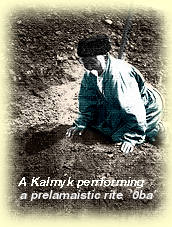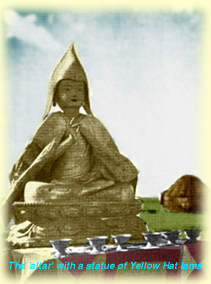At certain points in the Buddhistic service,
I think when the sacred name of Buddha recurs with fervor, the Chief Lama
covers his right arm as far as the wrist with the orange maniple
and pours three times a double libation on the sugared water into the brazen
dish, into which he had previously scattered a layer of the barleycorn.  Taking
up pieces of this mixture, the Lama flings them right and left, and then
dipping the aspergil into the holy water, he asperges the altar, but not
his fellow officiants nor the congregation, thus apparently indicating
an offering of the consecrated water to the Buddha. The maniple is shifted
to the left arm whenever he uses that arm to touch a sacred vessel. Taking
up pieces of this mixture, the Lama flings them right and left, and then
dipping the aspergil into the holy water, he asperges the altar, but not
his fellow officiants nor the congregation, thus apparently indicating
an offering of the consecrated water to the Buddha. The maniple is shifted
to the left arm whenever he uses that arm to touch a sacred vessel.
It is interesting to note that, on the top of the aspergil, is a peacock feather. Since the peacock is well known to be sacred to the evil or negative influence - I asked the officiant why he used this apparently malign emblem over the holy water. He replied that as it is an evil an "poisonous" thing, the peacock feather is intended to keep the malignant spirits from entering into a thus polluting the sacred water: an interesting example of oriental homeopathy ! As the service proceeded and finally came to
a grand climax, when it suddenly ended, the
The Belgrade Yellow Lama informed me that the
doctrine of transmigration is strictly held by this sect and that he teaches
his flock that while it is manifestly impossible for any person leading
the "world-life" to "get off the wheel of events" and attain anything approaching
to Nirvana, he can assure a better reincarnation to those of his people
who have "lived well", that is, who have followed the precepts of ordinary
morality, such as those against theft, adultery, an so forth.
|
 sounded
very like the prototype of our Amen.
sounded
very like the prototype of our Amen.